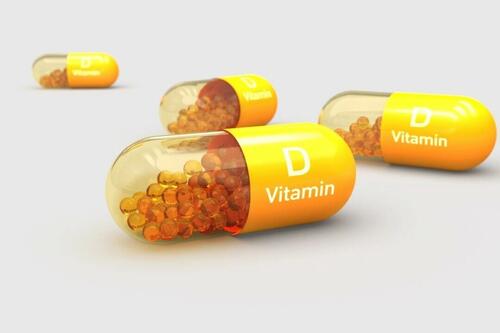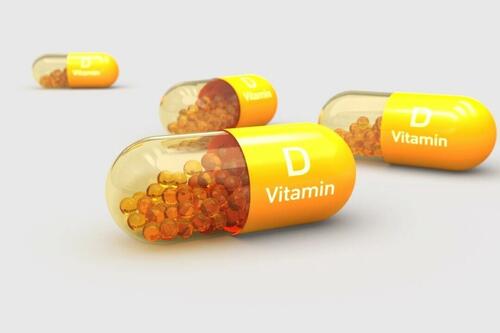
The Reality Of Vitamin D Supplementation
Authored by Sheramy Tsai via The Epoch Times,
One in five Americans regularly reach for vitamin D supplements, yet most are unaware that they’re taking not just a vitamin – but a hormone.
While renowned for bolstering bone strength and immune health, vitamin D’s story is not straightforward. A blend of myth and established science invites a closer look into its true nature and impact.
Vitamin D: Understanding Its Dual Role
Vitamin D stands apart in the world of nutrients. It’s a sun-sourced substance acting as both a nutrient and a hormone. This dual role is significant, as hormones, which orchestrate many bodily functions, aren’t typically taken as supplements like vitamins.
Endocrinologist Dr. Michael Holick, a leading vitamin D expert, tells The Epoch Times, “The body more effectively utilizes vitamin D when it’s naturally synthesized from sunlight, compared to standard supplement doses.”
This difference is key to understanding vitamin D’s health role and the complexities of supplementing a hormone.
Unlike most nutrients, the hormonal nature of vitamin D means it has a broader systemic impact, influencing not just bone health but also immune function, cell growth, and inflammation control. This understanding is crucial in guiding medical approaches to its use, including the potential risks and benefits of supplementation.
Beyond Bone Health
Vitamin D is more than just a bone health and immune system booster. Its multifaceted role in the body impacts everything from mood regulation to cardiovascular health.
At its core, vitamin D is vital for calcium absorption in the gut, and essential for bone strength and health. “Without enough Vitamin D, the body can only absorb 10–15 percent of calcium,” Dr. Alex Foxman, a leading internist and preventive care specialist, told The Epoch Times. Insufficient calcium can result in weaker bones and heightened fracture risks.
Moreover, vitamin D is pivotal for immune health. Dr. Holick observes, “Vitamin D receptors are in almost every cell, including immune cells.” Proper levels are vital for a balanced immune response and preventing autoimmune disorders.
Dr. Nathan Goodyear, an integrative cancer physician and director of Brio Medical, an integrative cancer treatment center in Scottsdale, Arizona, stresses vitamin D’s essential role in immune functionality and its influence on chronic diseases, like cancer. He explains, “The immune system does not work well if vitamin D is not optimal,” emphasizing its role in cancer, where immune strength is crucial.
Recent research, including melanoma studies, indicates that vitamin D supplementation can enhance treatment responses and prolong survival in cancer patients, even with currently insufficient daily dosage recommendations.
Vitamin D also plays a significant role in heart health.
Studies have linked low vitamin D levels to an elevated risk of heart disease. Those deficient in vitamin D are more likely to experience hypertension, heart failure, and strokes.
Mental health is another arena where vitamin D plays a significant role.
Kimberly Parker, a licensed psychotherapist, told The Epoch Times, “There’s a clear link between low levels of vitamin D and higher incidences of depression and mood disorders.”
It also affects seasonal affective disorder, a depression variant tied to seasonal changes. “I have seen my patients have a reduction of symptoms once they started to become consistent with their vitamin D intake,” she reports.
Vitamin D’s Journey From Sunlight to Cellular Powerhouse
Vitamin D is vital for health, existing in different forms, each taking a unique path within our body. Grasping these forms is key to understanding how vitamin D functions in our system.
Once vitamin D enters our body through sun, diet, or supplements, it transforms to become active.
First, it changes into calcidiol in the liver, then into calcitriol, its active form, in the kidneys. Dr. Holick clarifies, “Calcitriol is the form that our body can use to perform various functions.”
Interestingly, each form of vitamin D undergoes a similar conversion process in the body. The source of vitamin D might differ, but the pathway it takes in our bodies converges.
The conversion efficiency of vitamin D can differ. The skin’s capacity to produce vitamin D3 diminishes with age and is influenced by skin pigmentation, geographical location, and lifestyle.
Controversies in Vitamin D Testing
The routine way to measure vitamin D levels in the body is through a blood test called 25-hydroxyvitamin D. This measurement reflects vitamin D levels from sunlight, food, and supplements. The less recommended 1,25-dihydroxyvitamin D test fails to gauge vitamin D reserves, rendering it ineffective for patient monitoring.
Vitamin D blood testing has surged, ranking as Medicare’s eighth most common lab test. Market reports pegged the 2023 testing market at $677.5 million, with projections reaching $1.06 billion by 2031.
Once led by giants like Abbott, Siemens, and Quest Diagnostics, the vitamin D testing market is now seeing a surge in home testing kits from smaller companies. Dr. Holick recalls, “Years ago, I told Quest that this would be their number one seller.”
“More than 10 million vitamin D blood tests are done annually in the United States, even though these tests are not recommended by major medical organizations,” Dr. Morton Tavel, a cardiologist and specialist in internal medicine and cardiovascular disease, told The Epoch Times. He references a 2020 Virginia health system study, where 10 percent of patients underwent vitamin D tests, often without medical indication.
Beyond adults, vitamin D testing in children skyrocketed 30-fold in 15 years, as per a BMJ study, though it didn’t significantly alter low vitamin D diagnosis rates.
This increase in vitamin D testing contrasts with medical associations’ guidelines, which generally discourage routine testing in asymptomatic, low-risk individuals.
For instance, the Endocrine Society recommends screening only high-risk groups. The U.S. Preventive Services Task Force sees insufficient evidence for universal screening. Choosing Wisely also advises against testing in low-risk groups, including the general population.
Dr. Joel Finkelstein from Massachusetts General Hospital’s Bone Density Center, as reported in a Harvard Health blog, voices skepticism about the rampant vitamin D deficiency screening, deeming many checks on healthy individuals unnecessary.
“Vitamin D has been hyped massively,” he states. “We do not need to be checking the vitamin D levels of most healthy individuals.” He challenges the evolutionary need for high vitamin D, noting its limited presence in natural foods and reduced synthesis in darker skin, common in sun-rich areas.
However, many functional medicine and naturopathic doctors recommend regular vitamin D testing.
The College of Naturopathic Medicine advises those in sun-poor climates to test routinely for better health maintenance.
Aligning with this view, Dr. Goodyear emphasizes the tests’ relevance, particularly regarding inflammation and chronic diseases like cancer. He told The Epoch Times, “Vitamin D will always be low in the place of significant inflammation, both acute and chronic,” advocating for regular monitoring for proper supplementation.
Dr. Goodyear draws an analogy to salmon swimming upstream against a current of inflammation, illustrating the challenges in increasing plasma vitamin D levels in such conditions. He likens this process to standard medical practices like monitoring blood pressure, emphasizing the need for a similar approach in natural therapies, “The process is to evaluate, dose, re-evaluate, and then re-dose,” he adds.
Reflecting the views of Linus Pauling, considered to be the “father of vitamin C,” Dr. Goodyear criticizes the medical oversight of pharmacokinetics and dynamics in natural therapies. He explains that physicians learn drug dosage precision but often forget that this also applies to vitamins. He advocates for a tailored approach in vitamin D therapy, moving away from a one-size-fits-all methodology.
Defining Optimal Vitamin D Levels
According to the U.S. Preventative Services Task Force, “No consensus exists on the definition of vitamin D deficiency or the optimal level of total serum 25-hydroxyvitamin.”
Some experts view 25(OH)D levels under 30 ng/mL as deficient. Common standards suggest 30-60 ng/mL as sufficient. Yet, many functional health practitioners advocate for an optimal range of 50–80 ng/mL.
Recommendations according to the National Institutes for Health (NIH):
The NIH clarifies that optimal vitamin D levels are unestablished, as they “vary by stage of life, by race and ethnicity, and with each physiological measure used.”
Contrasting these guidelines, voices like Dr. Goodyear’s claim current vitamin D dose recommendations are too low. He labels the current U.S. recommended daily allowances as “woefully inadequate.”
Dr. Goodyear notes that the conventional focus on preventing rickets overlooks the broader health benefits of higher vitamin D levels. This stance argues for higher optimal ranges, implying current standards don’t fully exploit the vitamin’s health potential.
Too Much of a Good Thing?
Vitamin D is vital, however, there’s concern about its overconsumption, particularly via supplements. Unlike water-soluble vitamins, which our bodies can quickly expel when in excess, vitamin D is fat-soluble and can accumulate in the liver and fat tissues to harmful levels, termed “vitamin D intoxication.”
Dr. Holick cautions that vitamin D intoxication, though extremely rare, is severe. Sun exposure can’t cause Vitamin D toxicity, but excessive supplementation can. “Any excess vitamin D made by the sun is destroyed by the sun. You can never become vitamin D intoxicated from sun exposure, but you can from supplements if you take too much,” he warns.
Vitamin D toxicity triggers excessive calcium in the blood, leading to nausea, vomiting, and weakness. If untreated, it can escalate to kidney damage, bone pain, and, rarely, death.
Some practitioners, including Pam Schoenfeld, a registered dietitian, assert that excessive vitamin D intake can lead to the depletion of retinol, the active form of vitamin A. Ms. Schoenfeld told The Epoch Times, “The current landscape of vitamin D supplementation often neglects the intricate balance with other crucial fat-soluble vitamins.”
In an article for the Weston Price Foundation, Ms. Schoenfeld cautions, “More astute practitioners know that supplementing with vitamin D, especially at levels of 5,000 IU per day … is not advisable unless attention is paid to ensuring vitamin A intake is optimal.” This perspective emphasizes the delicate balance between these essential nutrients, suggesting that maintaining optimal levels of both is crucial for health, particularly during pregnancy.
Critics, like Dr. Holick, challenge this view, arguing that no substantial evidence supports the claim that Vitamin D adversely affects vitamin A levels. “It’s simply not true,” he notes.
The Vitamin D Supplementation Dilemma
Modern indoor lifestyles and diets low in vitamin D contribute to widespread deficiencies. Despite well-balanced diets, about 1 in 4 American adults and 70 percent of children fall short of necessary vitamin D levels.
Given these challenges, supplementation is an important consideration. Current recommendations call for 400 international units (IU) for children up to age 12 months, 600 IU for people ages 1 to 70, and 800 IU for people over 70.
Dr. Holick endorses supplements as a straightforward solution, especially for the sun-deprived, suggesting a total daily intake of 2000–3000 IU from diet, sun, and supplements.
However, not all practitioners agree that supplementation is necessary for everyone. “Although many studies had linked low levels of vitamin D to an assortment of medical conditions, when scientists tried administering it as a means to prevent or treat those problems, this ‘wonder’ supplement failed miserably,” Dr. Tavel told The Epoch Times.
Sunshine, a prime vitamin D source, can fulfill needs with minimal exposure. Dr. Tavel notes, “Your vitamin D storage generally lasts for about 10 to 12 weeks,” questioning the need for constant supplementation.
The vitamin D deficiency debate is complex. Dr. Tavel points out that “the widespread notion that much of America is walking around deficient in vitamin D came from a likely misinterpretation of the normal levels for vitamin D set by the Institute of Medicine more than a decade ago.” This has led to overestimation of deficiency rates and potentially unnecessary supplementation.
Yet, he explains, there are specific scenarios where supplementation is beneficial. The American Academy of Pediatrics advises 400 IU of vitamin D daily for breastfed infants. Those with medical conditions or limited sun exposure might also benefit.
Dr. Tavel warns that excessive supplementation, linked to increased fall risk and other hazards, underscores the need for balance in vitamin D intake.
Supporting Dr. Tavel, New England Journal of Medicine research found no fracture risk reduction in healthy adults supplementing with 2000 IU of vitamin D compared to non-supplementers.
Vitamin D’s necessity varies. Dr. Tavel reminds us, “For much of human history, people got their vitamin D mostly from the sun,” highlighting our body’s innate ability to regulate this nutrient.
Determining vitamin D supplementation requires personal assessment, medical consultation, and an eye on guidelines. Generally, a mix of diet, sun, and occasional supplements suffices for most, claims Dr. Tavel.
Expanding Vitamin D Supplement Industry
The vitamin D supplement market is rapidly growing, valued at $1,560 million in 2023 and expected to reach $2,780 million by 2033, growing at 5.9 percent annually. Drivers include an aging population, heightened health awareness, and a surge in demand for vitamin-enriched products.
In response to consumer demand, the industry is innovating with new delivery methods and formulations, like gummies, sprays, patches, creams, and potent capsules. This variety meets diverse preferences and needs, including ease of use and better absorption.
The industry’s growth is also propelled by robust marketing and advertising. Pharma and wellness firms heavily promote vitamin D supplements as key to health, shaping consumer views and fueling market expansion.
While this market growth mirrors a shift in health consciousness, it prompts concerns about self-prescribed supplementation and underscores the importance of a balanced approach to vitamin D consumption.
Best Sources of Vitamin D
Sun exposure is key in vitamin D production. UVB (ultraviolet B) rays convert skin cholesterol into vitamin D3, later transformed into calcitriol, its usable form. Interestingly, skin-produced vitamin D remains in the bloodstream for about twice as long as when ingested by food or vitamins.
Sunlight’s vitamin D productivity varies by time, season, and location. The best synthesis is between 10 a.m. and 3 p.m. in warmer months. However, above 37 degrees latitude, there’s negligible vitamin D production from November to March.
A 2022 study concluded, “Sun exposure can significantly make up for deficiencies in subjects who consume insufficient dietary Vit D. Compared with the extra cost and time for building habits of Vit D supplementation, moderate sun exposure appears to be a simple and costless means for the public to start in daily practice.”
The dminder app helps users identify optimal sun exposure times for vitamin D, offering real-time data based on location, time, and weather.
Dietary sources, though fewer, contribute to vitamin D intake. Fatty fish and UV-exposed mushrooms are key sources. Incorporating these foods can help maintain vitamin D, especially in less sunny periods.
Supplementation, particularly beneficial for those in higher latitudes, is another method. A study showed that while both sun and oral D3 supplements raise vitamin D levels, supplements were more effective due to compliance. Simply put, more people took supplements than spent time in the sun.
Vitamin D supplements are available as D2 (from plants) and D3 (from animals). D3, mirroring the body’s sun-induced production, is often recommended for effectively raising and maintaining vitamin D levels.
However, Dr. Holick asserts that “physiologic doses of D2 and D3 raise vitamin D levels in the blood the same,” effectively debunking myths about their differing impacts on health. Additionally, he confirms that the kidneys equally metabolize both forms.
Dr. Holick also touches on the regulatory history of these supplements in the United States, explaining that vitamin D2 remains the only pharmaceutical form available due to historical U.S. Food and Drug Administration approval processes. “No one ever got approval for D3,” he notes, highlighting a regulatory, rather than a health-based, reason for vitamin D2’s dominance in the market.
Though sunlight is the prime vitamin D source, its availability is inconsistent. Diet and supplements thus serve as vital alternatives to ensure sufficient vitamin D for optimal health.
Key Considerations for Vitamin D Supplementation
Understanding how to optimize vitamin D supplementation and reduce risks is crucial:
Fat-Soluble Nature
Contrary to popular belief and many recommendations, Dr. Michael Holick argues that vitamin D absorption doesn’t depend on dietary fat. He cites studies showing better absorption from skim milk, low in fat, than from full-fat milk. Hence, vitamin D can be taken with or without dietary fat.
Conjunction With Other Nutrients
-
Vitamin K: Studies suggest taking vitamins D and K together may enhance bone health and reduce arterial calcification risks.
-
Magnesium: Magnesium aids vitamin D metabolism, and high vitamin D doses can deplete magnesium levels. Adequate magnesium is vital for effective vitamin D use.
-
Vitamin A: Vitamins A and D, both fat-soluble, work together, but consensus on taking them together has not been clearly established.
-
Timing of Dosage: Some suggest aligning vitamin D intake with circadian rhythms, proposing daytime consumption to avoid sleep disturbances. However, Dr. Holick indicates no evidence supporting the idea that vitamin D disrupts sleep, making it safe to take at any time.
-
Choice of Vitamin D Type: While D2 (ergocalciferol) comes from plants and fortified foods and D3 (cholecalciferol) from animal products and sunlight exposure, Dr. Holick states both forms raise and maintain vitamin D levels equally.
-
Consult Health Care Professionals: Before starting supplements, consulting a health care provider is essential to determine proper dosing and assess potential interactions with other medications or health conditions.
While supplements may be useful, integrating them with natural vitamin D sources and a balanced lifestyle is crucial for overall well-being.
Tyler Durden
Sat, 04/06/2024 – 19:50











